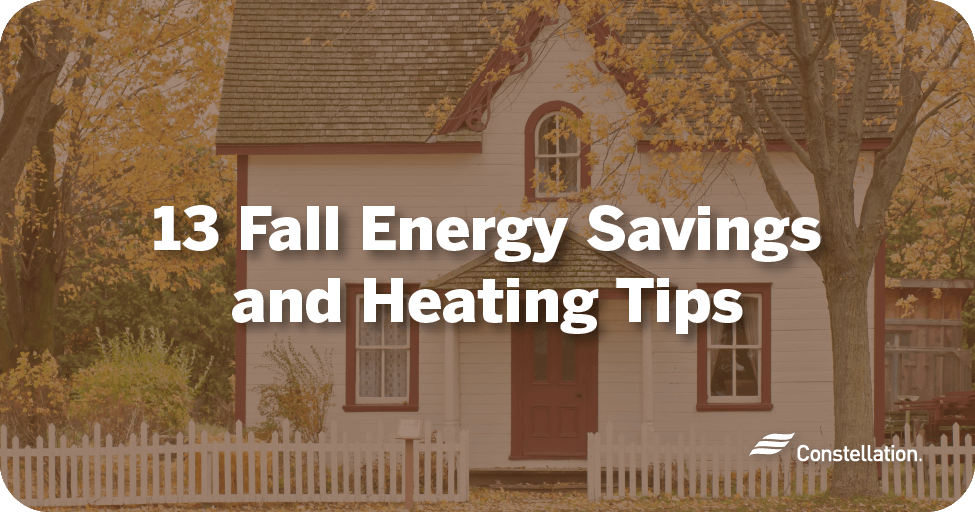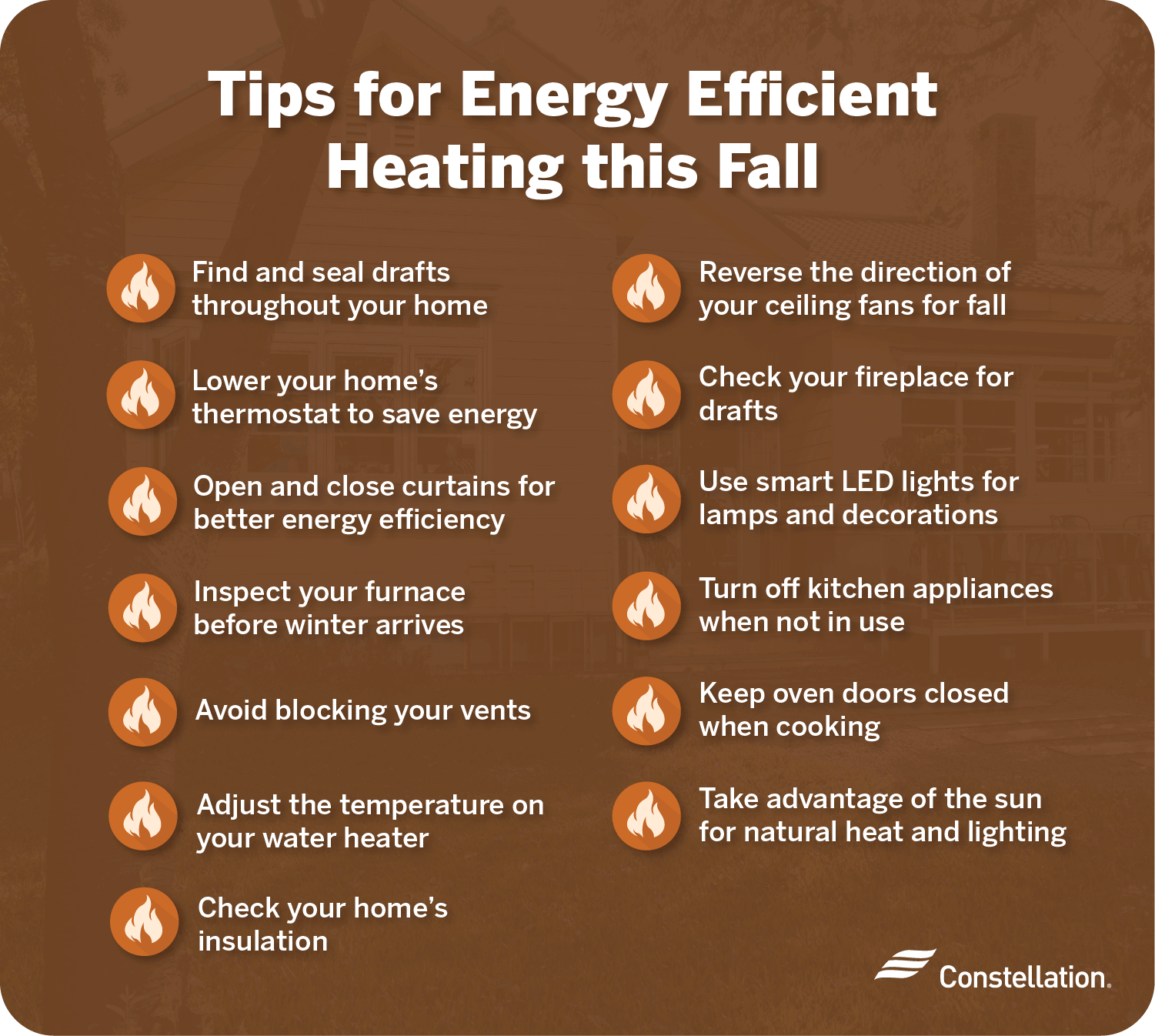
- Category:
Home Energy Savings -
Last updated:
October 3, 2022
13 Fall Energy Savings and Heating Tips for Your Home
These fall energy saving tips can help you lower your heating bill and reduce wear and tear on your heating system. When you turn the heat on in the fall, you want to make sure your home is winter ready. From giving your heating system a thorough checkup to beefing up your insulation, we share these energy saving ways to heat your home and cut energy use.
Tips for energy-efficient heating this fall
These energy-saving tips for fall will not only keep your home running efficiently, they will also make your home more comfortable.

1. Find and prevent drafts throughout your home
One of the fastest and easiest upgrades you can make to save energy is adding, replacing and increasing weatherstripping around gaps in your home. The areas around windows, doors, and places where utilities enter your structure are prime sources for letting in cold drafts.
Not all weatherstripping is alike. Choose the right types of weatherstripping for each application. Sealing a garage door involves different weatherstripping than you would use for a window. When sealing cracks in your foundation, you may find caulk is the better option.
2. Lower your home’s thermostat to save energy
Thermostat energy saving tips address questions such as at what temperature should I set my thermostat and when should I turn on the heat in my house this fall.
Running your heating system less often will save energy, so setting your thermostat at a lower temperature will help. Keep your thermostat between 68 and 70 degrees during the day and lower at night.
Many people forget to lower their thermostats at night. One of the benefits of a smart thermostat is that you don’t have to rely on your memory. The thermostat will adjust the temperature according to the schedule that you set.
3. Open and close curtains for better energy efficiency
The sun is an incredible source of heat, even in the fall. Harness the sun’s energy in simple ways. One of the best heating tips is to open curtains and drapes when the sun shines through your windows. Solar heat that enters through a well-insulated window can raise the temperature in a room by several degrees — without your heater having to do extra work. Pull your curtains tightly closed to add another layer of insulation against the cold outdoors when the sun moves on.
4. Inspect your furnace before winter arrives
One of the best fall energy saving tips is to have an expert HVAC professional inspect your furnace. Regular seasonal inspections let you address issues before they become a problem, preventing things like a middle-of-the-night breakdown in below zero weather. HVAC inspections keep your system running efficiently all year.
Another of the classic home heating energy saving tips is to clean your system regularly. Dirty ducts and filters clogged with debris make your furnace work harder than it needs to to heat your home. When you turn the heat on in the fall, it’s also the perfect time to replace your filters. They’re inexpensive and easy to install, and go a long way to helping you capture fall energy savings.
5. Don’t block your vents
Check around your home to make sure air can flow freely from your vents. Furniture or drapes that block vents waste energy by preventing heat from freely flowing into the room and circulating. If you can’t move the furniture or drapes, an easy solution is to buy inexpensive vent extenders that direct air from vents under sofas or behind drapes out into the room.
6. Use less energy for water heating during the fall
No list of fall energy saving tips would be complete without mentioning your hot-water heater. Check the temperature setting to make sure it isn’t set too high. For most people, temperatures between 110 and 120 degrees are hot enough for washing dishes and bathing.
Another way to save energy in your home and increase its energy-efficiency is adding an insulating blanket over your water heater. Home improvement and hardware stores sell them in a variety of shapes and sizes to easily fit around your unit to hold in heat.
7. Check your home’s insulation
If you haven’t checked your insulation in a few years, take the time to do it now. Believe it or not, insulation does wear out. Over time it settles and loses the air pockets that make it effective.
Manufacturers are always working to improve their products, so you have plenty of new attic insulation types that are worth the investment of time and money. Adding to or replacing existing material can help you with attic insulation cost savings that make your entire home more efficient and comfortable year round.
8. Reverse the direction of your ceiling fans for fall
Improving the circulation of heat is another way to reduce the time your heating system operates. Which way a ceiling fan should turn in the summer is different than in the winter. Warm air rises, making the warmest air in the room near the ceiling. Reversing that is one of the common energy saving tips for fall.
Adjust the fan to run clockwise at a low speed in the winter to draw cold air up from the floor. As it flows upward, it pushes the warm air out toward your walls and down into your living space.
9. Check your fireplace for drafts
Your fireplace could be a source of cold drafts more often than a source of heat. The chimney and flue open to the outside and thus can be a major source of lost heat. Rising heat could rush up through your chimney and out of your home.
When thinking of ways to heat your home and save energy, stopping this heat loss is vital. Repair a loose or damaged damper so your chimney will not suck heat from your room. Keep it closed when you don’t have a fire. Adding glass doors over your fireplace opening will let you enjoy the fire and its heat, while preventing warm room air from going up the chimney. You can also cover the fireplace opening when you’re not using it to put a stop to drafts.
10. Use smart LED lights for lamps and decorations
Fall energy saving tips include replacing inefficient incandescent light bulbs. LED lights use far less energy. When you connect them to smart home systems that automate their operation, you can really save money. Smart lighting can be used with holiday decorations to ensure you are making the most efficient use of electricity in your home.
11. Switch off kitchen appliances when not in use
Modern appliances often continue to draw power, even in the off position. Unplug appliances to save energy and stop these electricity vampires from running up your electric bill.
12. Keep oven doors closed when cooking
One of the easy ways to save energy in your home is to change your habits. Resist the temptation to check on your food by opening your oven, air fryer or microwave during cooking. Keeping the doors closed helps the appliances evenly maintain the proper cooking temperature and prevent the wasteful loss of heat that increases their energy use.
13. Take advantage of the sun for natural heat and lighting
Sunlight is a natural and powerful source of energy all year round. In the fall, you can capture and use its power by letting its light into your windows. Adding solar panels is another of the home energy options that can make your house more efficient. You don’t have to invest in an expensive house-wide system. Connect small portable solar panels to power stations that can run small appliances. These low investment and low commitment systems are also nice to have around if a winter storm knocks out power.




